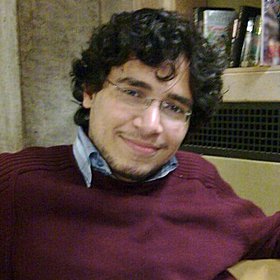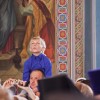Part IV
What Now?
Exclusive to Pravmir
Edited by Elizabeth J Iskander
Part III Monophysitism, Then and Now
Part II – b Historical and Doctrinal Premises
Part II – a Historical and Doctrinal Premises
Part I The Ecumenical Statements: Hoping for a Fresh Orthodox Perspective
 Introduction
Introduction
In the previous installments in this series of articles, I shed some light on the existence and nature of the Christological disagreement between the Council of Chalcedon and the oriental churches that refused its decrees. In this final article of the series, I will highlight the current situation in the Coptic Church, as the largest and most influential oriental church, plus the theological difference as a result of the Christological disagreement. This will lead me propose some recommendations for future orthodox-oriental dialogue, which is crucial because, as the Egyptian scholar George Bebawi,[1] says: “Dioscorus of Alexandria who rejected the Council of Chalcedon (451) made a huge mistake and I don’t know how we can correct it.”[2]
The Doctrinal consequences today
The current situation of the Coptic Church is a consequence of this move by Dioscorus. But his decision was not abstracted from the context of Egypt in the fifth century. Historically, Egypt was a fertile land for the growth of different philosophical movements, including Gnosticism. Egypt also had a very strong nationalistic movement. After the schism in 451, the Coptic Church, and later the Syrian, expressed strong nationalist sentiments. Copts showed a clear enmity towards everything “Greek”. This led to a sort of insulation from the Catholic Church, which was described by Copts as the church of the Emperor and so was labeled as Melkite.
As a result of the Coptic rejection of the writings of the Fathers and anything related to Byzantium, the monastic movements in Egypt developed a spiritual alternative movement influenced by the Egyptian Gnostic philosophy which undermined the body and overlooked the fact of Christ’s complete incarnation. This shaped Oriental spirituality, with its Monophysite Christology. As explained in the previous articles, this expels deification and any sort of communion between God and man. That is why Severus of Antioch, in his explanation of Christology, refuses deification.[3]
Another influential factor with consequences for the Coptic Church was the Islamic victory in Egypt. The influence of Islamic culture and though can he seen in the writings of the current Coptic Patriarch, Shenouda III. He easily adopts the Severian and other oriental attitudes in order to reconcile with Islamic understanding of the impossibility of having a God-man communion.
Shenouda says: “it is impossible that any of the fathers of the church taught deification.”[4] This comes within the context of Shenouda’s series of excommunications against his opponents, including Bebawi, regarding their attempts to bring back the patristic tradition. Stephen Davies, from Oxford University, says: “Shenouda’s objection to this doctrine (Deification) is also motivated by particular cultural and interreligious sensitivities… This latter concern comes to expression in an extraordinary and unprecedented fashion when the patriarch adopts the language of Muslim anti-Christian diatribe and directs that polemical rhetoric against the monks of St. Macarius Monastery. First, he criticizes Mathew the Poor and his followers for being guilty of Al-Tahrif,[5] the ‘corruption’ of Scripture”.[6]
Then Shenouda explains the mystery of Eucharist by dividing Christ, as the Severian Christology acknowledged, taking only the human nature without the divine nature. He says: “Our Master Christ said, “who eats my body and drink my blood” (Jn 6:56) he did not say who eats my divinity and drink my divinity…God is Spirit (Jn 4:24) and Spirit cannot be eaten or drank Moreover the one who eats the divine nature and remains in him will become after receiving communion a god and those in church worship him. Also here is another problem: what about those who receive unworthy? Do they also eat the divinity and drink the divinity and thus eat judgment (1Cor 11:29)?”[7]
Again, those who rejected Shenouda’s explanation had to face his Islamic accusations. Davis quotes Shenouda with a good analysis by saying: “Second, and even more pointedly, he accuses them of committing al-Shirk billah (‘the act of associating something with God’). The charge of al-shirk represents a standard Muslim criticism directed against proponents of Christian Trinitariandoctrine; in this case, however, Shenouda employs this language against a fellow Christian as an expression of opposition to the doctrine of deification.”[8]
New definitions of almost every Christian doctrine, including the Trinity, have been developed by the Oriental communion and particularly the Coptic one. These issues, at least for the Coptic Church, cannot be ignored. These are serious issues that led the Patriarch to excommunicate scholars and forbid publishing books and taking strong verdicts against a complete monastery ( forbidding reading the st. Macarius Monastery publishings and isolating monks from the church). Consequently, the Orthodox Church needs to take the Coptic stance regarding doctrines like Eucharist and sanctification seriously as well.
Recommendations for a positive Ecumenical Dialogue
The issue of orthodox-oriental dialogue is crucial. As Bebawi has said, “The present condition of the Coptic Church – Isolated, poor, oppressed, and lacking the richness of the Patristic tradition – is very sad, although the dialogue with the Orthodox has been going on intermittently for centuries.”[9] But to pursue a Theological dialogue that can bring forth good results, the two sides need to start again from the beginning a serious study of each other’s tradition and theology.
The Coptic church will never accept St. Leo of Rome or Chalcedon if it stays stuck in the Coptic medieval classics that distorted the image of the Catholic Christology. On the other hand, the Orthodox Church needs to know more what happened and what is happening on the other side of the Mediterranean. The theological developments of the Coptic Church has created a huge diversion from the Orthodox one.
I believe part of the problem is the mistaken attitude of the previous dead dialogue. That dialogue accelerated the attempts for unity, and overemphasized the closeness of the doctrines without having a serious and careful understanding of what is beyond Christology.
In my opinion, the results of the Orthodox-Roman Catholic dialogue achieved a milestone with the Ravenna Document. This document determined exactly their agreement upon their disagreements (!). Consequently they knew what they really need to study together. This is exactly what the Orthodox-Oriental Dialogue needs today.
The Russian Orthodox Patriarchate should take a strong positive stance regarding the dialogue by summoning the different oriental traditions (Armenian, Syrian and Coptic) to have a deep theological dialogue. This would make me optimistic that Moscow can heal the dialogue … with all hopes that “all may be one”(John 17:21)
Special thanks:
I’d like to express my deep gratitude to Pravmir magazine for hosting this series of articles and its loyal and spiritual contribution to the Christian electronic journalism.
I also would like to thank my partner and fiancйe, Elizabeth Iskander, who spent of her time, while defending her PhD thesis in Cambridge University, in editing the language and structure of the articles.
Brookline-Massachusetts
United States of America
[1] a former teacher at Cambridge Divinity School and recently excommunicated by the Coptic Church, leading him to join the Russian Orthodox Church
[2] Road to Emmaus Orthodox Magazine, Issue 38. P.27
[3]Cf. Center for Traditionalist Orthodox Studies, The Non-Chalcedonian Heretics, p.17
[4] Shenouda III, Comparative Theology 5, p.5
[5] This is an Islamic expression referring to the grave apostasy of changing God’s words.
[6] Davis, Stephen J. Coptic Christology in Practice, Oxford University Press. P.277
[7] Shenouda III, op. cit. p.18
[8] Davis. Op. cit. p.278 qouting Shenouda op. cit. p.31
[9] Ibid. pp. 27-28















